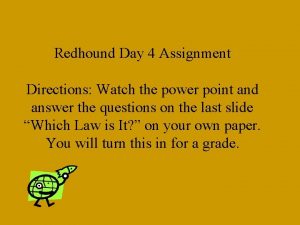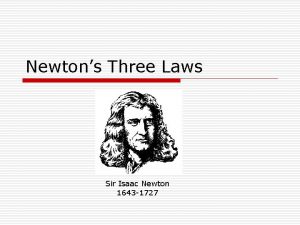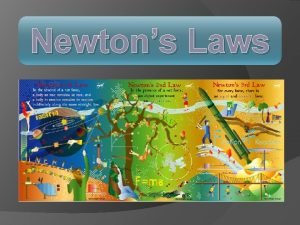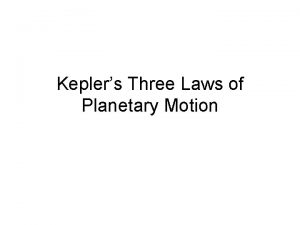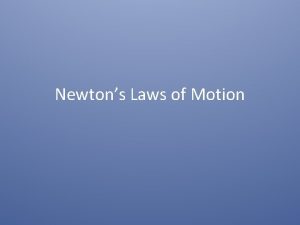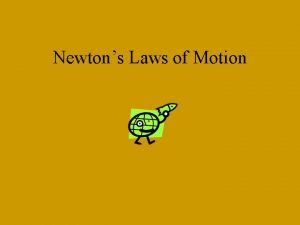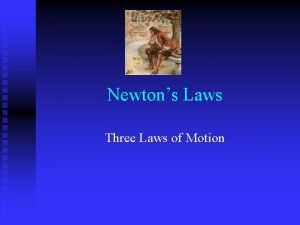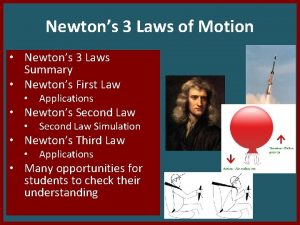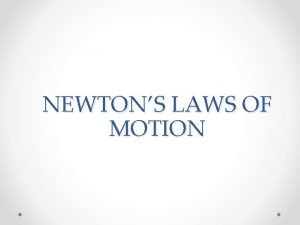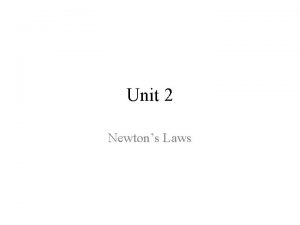The Laws of Motion Newtons Three Laws What












- Slides: 12

The Laws of Motion Newton’s Three Laws

What is a Force? It is something we experience every single day. You are exerting a force on your pencil right now as you copy these notes or perhaps you are pressing down on computer keys Even if you think to yourself, “well I am not taking notes, ” you are still experiencing the force of gravity pulling you down and your chair exerting a force up so…there is no escape from the force of gravity! Well there is…but we will get to that in another lecture…

Newton’s First Law If an object does not interact with any other objects, it is possible to identify a reference frame in which the object has zero acceleration This is called an “inertial reference frame” All inertial reference frames can be related to each other by constant velocities Inertial reference frames DO NOT accelerate relative to each other Be careful: not all reference frames are inertial!

Newton’s First Law (cont. ) In terms of a reference frame, imagine you have an air hockey table inside a train moving 20 m/s relative to the ground. A hockey puck on the table, experiencing almost no friction, appears to not be moving but we know the train is moving so the puck must also be moving at 20 m/s relative to the ground. Both velocities for the air hockey puck are correct in their respective reference frames…

Newton’s First Law (cont. ) If the train were to speed up or slow down, the puck would then begin to move and maintain its 20 m/s speed because there is no friction between it and the table and nothing to act on it to change its velocity So the first law can be stated: A body at rest or at constant velocity in the absence of an external force will remain at rest or at constant velocity In other words, when no force acts on an object, the acceleration of the object is zero

Newton’s Second Law But what happens to an object when a force acts on it? Imagine exerting a force on the air hockey puck and pushing it across the frictionless surface. The block must have experienced a change in velocity (i. e. an acceleration) if it went from stationary to moving. The more force you apply, the more the block will accelerate There is a direct relationship between force and acceleration

Newton’s Second Law (cont. ) What else affects the acceleration? Would a larger block accelerate as quickly with the same amount of force it took to move the first one? The answer is no – it would take more force to move the larger block at the same acceleration So there is an inverse relationship between acceleration and a property of the object called its “mass”. Mass is a measurement of an object’s resistance to acceleration!

Newton’s Second Law (cont. ) When viewed from an inertial reference frame, the acceleration of an object is directly proportional to the net force acting on it and inversely proportional to it’s mass This is represented by the formula: This is in general a VECTOR equation; both force and acceleration are vectors! The total acceleration (if there are multiple forces) can be found as a vector sum.

Newton’s Second Law (cont. ) A simple example: If a block had a mass of 10 kg and the force you applied accelerated it by 10 m/s 2, what is the magnitude of the force? How much force would you need to apply to a larger block that had a mass of 50 kg in order to achieve the same acceleration? What are the units of these forces?

Newton’s Third Law The Law of Action and Reaction If two objects interact, the force exerted by object 1 on object 2 is equal in magnitude and opposite in direction to the force exerted by object 2 on object 1 If they were added together, the sum of those two forces is zero because they are equal in magnitude and opposite in direction (which would mean they cancel each other out) So, if every force produces an equal and opposite reaction force, how does anything ever move?

Newton’s Third Law (cont. ) Imagine book sitting on a table. It is not moving because the table is exerting a force up equal the amount of force down that the earth is pulling on the book. But this force the table is exerting is not the reaction force Newton’s Second Law is talking about. The reaction force is that the book is also pulling on the earth with the same amount of force that the earth is pulling on the book – the is the true equal and opposite reaction force! Notice that the reaction force ALWAYS ACTS ON A DIFFERENT OBJECT!

Review First Law: A body at rest tends to stay at rest unless acted on by an external force and an object in motion tends to stay in motion unless acted on by an external force Second Law: The acceleration of an object is directly proportional to vector sum of the forces acting on it and inversely proportional to its mass Third Law: For every action there is an equal and opposite reaction
 Newtons laws od motion
Newtons laws od motion Newtons first lw
Newtons first lw The 3 law of motion
The 3 law of motion Newton's three laws
Newton's three laws Newtons three law
Newtons three law Three laws of newton
Three laws of newton What are the 3 laws of newton
What are the 3 laws of newton Who formulated the three laws of motion
Who formulated the three laws of motion Kepler's three laws of planetary motion
Kepler's three laws of planetary motion What are the laws of motion
What are the laws of motion The laws of gravity
The laws of gravity Newton's 3 laws
Newton's 3 laws Newtons laws of gravity
Newtons laws of gravity




